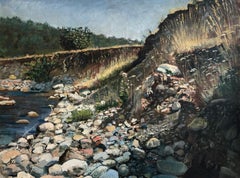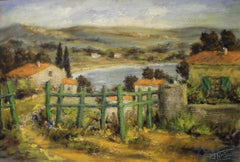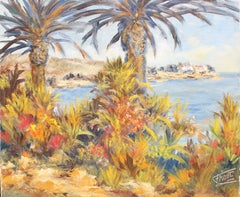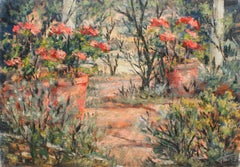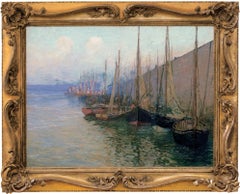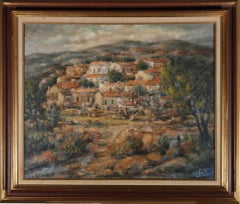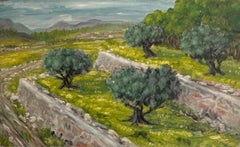Félix Tisot Art
French, 1909-1979
Atelier Félix TISOT (1909-1979)
Félix TISOT my father once wrote this powerful sentence: "Our eyes open when those of ours close". This quote came back to my memory while I was walking, not long ago, at the Orsay museum on the floor of the Impressionists. Most of the masterpieces that paraded before my eyes seemed to make me an eye because I discovered in each of them the same colors as found in the works of my father who is now gone. Yes, "our eyes open when those of ours close." Up to Claude Monet's Gare Saint-Lazare where I imagined that the olive trees of the Midi landscapes painted by my father could have taken root under its canopy, thus hampering the smooth running of the locomotive entering the Paris station . I was flabbergasted. It was a fact, The poppies of Claude Monet or Chemin ascending in the tall grass of Pierre-Auguste Renoir exhale the same heat which escapes from the fabrics of Félix TISOT, as in La route de Louveciennes by Camille Pissarro however covered of snow. How did my father manage to appropriate light and colors, blues, ochres, greens, whites, yellows, violets by Renoir, Monet, Pissarro, Bazille, Cézanne , Sisley and even Degas to project them into his paintings? Félix TISOT would therefore be "the last of the Impressionists"? The day will come when he will be recognized as such, I trust! I want to quote an anecdote. My father spent the last seven years of his life in the company of Suzy, my mother with me in Paris. The success of his exhibitions was such that he liked to say: "Paris, for me, is Lourdes! "Sometimes he would compose his landscapes in Sanary in the Var when he resided there, but when he came back to Paris, observing his paintings, he found himself quite crumpled:" Damn! Where did the light go? "It was easy to understand: in the South no need to put light in a canvas, the light is in the air, it is ambient and bathes the canvas. But once in Paris, we realize that the light has remained below. With brush strokes, you have to strive to reconstruct in the canvas this light of the South without whom things would be only what they are. Félix TISOT, my father, then got down to it, joining by the great mystery of the imagination, the luminance of the canvases of the great Impressionists which was imprinted in his memory. Thus, "his eyes opened when those of the famous Impressionists closed".
Henri TISOT (1937-2011), actor, the son of the painter Félix TISOT who considered it the most beautiful work of his life. Sacred Dad!
(Biography provided by Stephanie's Art Gallery, Inc.)
to
4
1
4
3
2
1
3
1
Overall Height
to
Overall Width
to
4
4
4
1
1
1
1
1
1
5
4
5
6,946
3,298
2,514
1,213
5
5
Artist: Félix Tisot
Provence
By Félix Tisot
Located in Genève, GE
Work on canvas
Golden wooden frame
68.5 x 85 x 5 cm
Category
Mid-20th Century Félix Tisot Art
Materials
Oil
The French Village, Le Mas.
By Félix Tisot
Located in La Canada Flintridge, CA
Artist signed lower right, 32"x25.25", oil on canvas.
Category
1970s Impressionist Félix Tisot Art
Materials
Oil
The quiet little port
By Félix Tisot
Located in La Canada Flintridge, CA
The painting size is 21.75x15 in. unframed, with framed size is 24.5x17.5 in. Artist signed lower right. Gallery certificate of authenticity is included.
Category
1970s Impressionist Félix Tisot Art
Materials
Oil
Palm Beach
By Félix Tisot
Located in La Canada Flintridge, CA
"Palm Beach" very summery color composition done by Franch painter Félix TISOT in 1974. It is in very good condition. Framed gold wood. Complimentary cust...
Category
1970s Impressionist Félix Tisot Art
Materials
Oil
Botanical Garden
By Félix Tisot
Located in La Canada Flintridge, CA
French painter Félix TISOT signed lower right.
Titled "Bohemian La Bastide" botanical garden, in France. Gallery certificate of authenticity is include...
Category
1970s Impressionist Félix Tisot Art
Materials
Oil
Related Items
" Summer Evening Southwest Texas " 1909 Texas Hill Country
By Julian Onderdonk
Located in San Antonio, TX
Julian Onderdonk "Summer Evening S. W. Texas" Texas Hill Country
(1882 - 1922)
San Antonio Artist
Image Size: 9 x 12
Frame Size: 15 x 18
Medium: Oil on panel
Dated 1909
"Summer Evening S. W. Texas"
"A Texas Painter Worked Under the Radar in New York," By Eve M. Kahn, March 6, 2014, The New York Times
Onderdonk, a San Antonio native who died of an intestinal ailment in 1922, at 40, is best known for painting swaths of Texas bluebonnets. Those canvases can bring more than $500,000 each, while his New York scenes usually end up in the five-figure range.
Onderdonk’s parents were painters in San Antonio, and in 1901, when he was a teenager, they sent him to New York for training. Through 1909, he lived in various Manhattan apartments and Staten Island houses. He then returned to Texas, but continued to spend months at a time in New York.
In 1902 he had married a Manhattan teenage neighbor, Gertrude Shipman. While she focused on raising their daughter, Adrienne, and worrying about their strained finances, “he created more than 600 works of art, often producing a painting or two a day,”
Eyewitnesses recorded his prolific pace in New York, but Onderdonk works bearing those dates rarely turn up. The puzzling gap in his productivity is explained in family correspondence that the Bakers uncovered: The artist admits that he was signing pieces with pseudonyms. He mostly used Chas. Turner and Chase Turner and occasionally resorted to Elbert H. Turner and Roberto Vasquez.
Julian Onderdonk was the son of the important Texas landscapist, Robert Onderdonk. He was the father's pupil at age 16. Sponsored by a Texas patron, he studied at the Art Students League in New York when he was 19, the pupil of Kenyon Cox, Frank DuMond, and Robert Henri. He also studied with William Merritt Chase on Long Island. In 1902, having lost his Texas patron because he married, he asked $18 for 12 paintings at a Fifth Avenue dealer in New...
Category
Early 1900s Impressionist Félix Tisot Art
Materials
Oil
H 15 in W 18 in D 4 in
"In Port"
By Edward Willis Redfield
Located in Lambertville, NJ
Jim’s of Lambertville is proud to offer this artwork by:
Edward Willis Redfield (1869 - 1965)
Edward W. Redfield was born in Bridgeville, Delaware, moving to Philadelphia as a young child. Determined to be an artist from an early age, he studied at the Spring Garden Institute and the Franklin Institute before entering the Pennsylvania Academy from 1887 to 1889, where he studied under Thomas Anshutz, James Kelly, and Thomas Hovenden. Along with his friend and fellow artist, Robert Henri, he traveled abroad in 1889 and studied at the Academie Julian in Paris under William Bouguereau and Tony Robert-Fleury. While in France, Redfield met Elise Deligant, the daughter of an innkeeper, and married in London in 1893.
Upon his return to the United States, Redfield and his wife settled in Glenside, Pennsylvania. He remained there until 1898, at which time he moved his family to Center Bridge, a town several miles north of New Hope along the Delaware River. Redfield painted prolifically in the 1890s but it was not until the beginning of the twentieth century that he would develop the bold impressionist style that defined his career. As Redfield’s international reputation spread, many young artists gravitated to New Hope as he was a great inspiration and an iconic role model. Edward Redfield remained in Center Bridge throughout his long life, fathering his six children there.
Around 1905 and 1906, Redfield’s style was coming into its own, employing thick vigorous brush strokes tightly woven and layered with a multitude of colors. These large plein-air canvases define the essence of Pennsylvania Impressionism. By 1907, Redfield had perfected his craft and, from this point forward, was creating some of his finest work.
Redfield would once again return to France where he painted a small but important body of work between 1907 and 1908. While there, he received an Honorable Mention from the Paris Salon for one of these canvases. In 1910 he was awarded a Gold Medal at the prestigious Buenos Aires Exposition and at the Panama-Pacific Exposition of 1915 in San Francisco, an entire gallery was dedicated for twenty-one of his paintings.
Since Redfield painted for Exhibition with the intent to win medals, his best effort often went into his larger paintings. Although he also painted many fine smaller pictures, virtually all of his works were of major award-winning canvas sizes of 38x50 or 50x56 inches. If one were to assign a period of Redfield’s work that was representative of his “best period”, it would have to be from 1907 to 1925. Although he was capable of creating masterpieces though the late 1940s, his style fully matured by 1907 and most work from then through the early twenties was of consistently high quality. In the later 1920s and through the 1930s and 1940s, he was like most other great artists, creating some paintings that were superb examples and others that were of more ordinary quality.
Redfield earned an international reputation at a young age, known for accurately recording nature with his canvases and painting virtually all of his work outdoors; Redfield was one of a rare breed. He was regarded as the pioneer of impressionist winter landscape painting in America, having few if any equals. Redfield spent summers in Maine, first at Boothbay Harbor and beginning in the 1920s, on Monhegan Island. There he painted colorful marine and coastal scenes as well as the island’s landscape and fishing shacks. He remained active painting and making Windsor style furniture...
Category
Early 1900s American Impressionist Félix Tisot Art
Materials
Canvas, Oil
"Winter Storm, NYC"
By Johann Berthelsen, 1883-1972
Located in Lambertville, NJ
Jim’s of Lambertville Fine Art Gallery is proud to offer this piece by Johann Berthelsen (1883 – 1972).
Born in 1883 in Denmark to artistically inclined parents, Johann Berthelsen would become a widely successful singer, teacher, and painter. After his parents divorced, his mother brought Berthelsen and his siblings with her to the United States in 1890, eventually settling in Wisconsin.
At eighteen, Berthelsen moved to Chicago in the hope of becoming an actor, but a friend at the Chicago Musical College convinced him to audition at his school. Berthelsen received a full scholarship and enrolled at the college, where he was awarded the Gold Medal twice. After graduating, he had an active career traveling across the United States and Canada performing in operas and concerts, before joining the voice faculty at his alma mater in 1910. In 1913, Berthelsen became the voice department director at the Indianapolis Conservatory of Music.
While in Chicago, Berthelsen met the landscape painter, Svend Svendsen...
Category
20th Century American Impressionist Félix Tisot Art
Materials
Oil, Canvas
"Forest Strongholds"
By John F. Carlson
Located in Lambertville, NJ
Signed lower right. Complemented by a hand carved and gilt frame.
Exhibited at the National Academy of Design, 1928
Category
20th Century American Impressionist Félix Tisot Art
Materials
Canvas, Oil
"Le Dompteur de Pigeons" (ex. Christie's) - Large Antique Impressionist Painting
By Georges Jules Victor Clairin
Located in New Orleans, LA
A large, spectacular, absolutely splendid painting by noted French painter Georges Clairin, which appeared for auction at Christie's in 2004 (see photo...
Category
Late 19th Century Impressionist Félix Tisot Art
Materials
Oil
Winter Moonlight
By George William Sotter
Located in Lambertville, NJ
signed lower right
Category
1910s American Impressionist Félix Tisot Art
Materials
Canvas, Oil
View on the Hudson, the Catskills in the Distance
By Francis Augustus Silva
Located in New York, NY
Signed lower right: F.A. SILVA.
Category
Late 19th Century Hudson River School Félix Tisot Art
Materials
Oil, Canvas
A Trail through the Trees
By Albert Bierstadt, 1830-1902
Located in New York, NY
Monogrammed lower left: ABierstadt
Category
19th Century Hudson River School Félix Tisot Art
Materials
Board, Oil
"The Canal"
By Edward Willis Redfield
Located in Lambertville, NJ
Jim’s of Lambertville is proud to offer this artwork.
Signed lower left. Complemented by a hand carved and gilt frame.
Illustrated in "Edward Redfield: Just Values and Fine Seeing" by Constance Kimmerle and the Pennsylvania Academy of the Fine Arts's Exhibition of Paintings by Edward Redfield (April 17 to May 16, 1909) brochure
Edward Willis Redfield (1869 - 1965)
Edward W. Redfield was born in Bridgeville, Delaware, moving to Philadelphia as a young child. Determined to be an artist from an early age, he studied at the Spring Garden Institute and the Franklin Institute before entering the Pennsylvania Academy from 1887 to 1889, where he studied under Thomas Anshutz, James Kelly, and Thomas Hovenden. Along with his friend and fellow artist, Robert Henri, he traveled abroad in 1889 and studied at the Academie Julian in Paris under William Bouguereau and Tony Robert-Fleury. While in France, Redfield met Elise Deligant, the daughter of an innkeeper, and married in London in 1893.
Upon his return to the United States, Redfield and his wife settled in Glenside, Pennsylvania. He remained there until 1898, at which time he moved his family to Center Bridge, a town several miles north of New Hope along the Delaware River. Redfield painted prolifically in the 1890s but it was not until the beginning of the twentieth century that he would develop the bold impressionist style that defined his career. As Redfield’s international reputation spread, many young artists gravitated to New Hope as he was a great inspiration and an iconic role model. Edward Redfield remained in Center Bridge throughout his long life, fathering his six children there.
Around 1905 and 1906, Redfield’s style was coming into its own, employing thick vigorous brush strokes tightly woven and layered with a multitude of colors. These large plein-air canvases define the essence of Pennsylvania Impressionism. By 1907, Redfield had perfected his craft and, from this point forward, was creating some of his finest work.
Redfield would once again return to France where he painted a small but important body of work between 1907 and 1908. While there, he received an Honorable Mention from the Paris Salon for one of these canvases. In 1910 he was awarded a Gold Medal at the prestigious Buenos Aires Exposition and at the Panama-Pacific Exposition of 1915 in San Francisco, an entire gallery was dedicated for twenty-one of his paintings.
Since Redfield painted for Exhibition with the intent to win medals, his best effort often went into his larger paintings. Although he also painted many fine smaller pictures, virtually all of his works were of major award-winning canvas sizes of 38x50 or 50x56 inches. If one were to assign a period of Redfield’s work that was representative of his “best period”, it would have to be from 1907 to 1925. Although he was capable of creating masterpieces though the late 1940s, his style fully matured by 1907 and most work from then through the early twenties was of consistently high quality. In the later 1920s and through the 1930s and 1940s, he was like most other great artists, creating some paintings that were superb examples and others that were of more ordinary quality.
Redfield earned an international reputation at a young age, known for accurately recording nature with his canvases and painting virtually all of his work outdoors; Redfield was one of a rare breed. He was regarded as the pioneer of impressionist winter landscape painting in America, having few if any equals. Redfield spent summers in Maine, first at Boothbay Harbor and beginning in the 1920s, on Monhegan Island. There he painted colorful marine and coastal scenes as well as the island’s landscape and fishing shacks. He remained active painting and making Windsor style furniture...
Category
Early 1900s American Impressionist Félix Tisot Art
Materials
Canvas, Oil
Niagara Falls with View of Clifton House
By Jasper Francis Cropsey
Located in New York, NY
Signed and dated right of center: J.F. Cropsey / 1852
Category
Mid-19th Century Hudson River School Félix Tisot Art
Materials
Canvas, Oil
Autumn Landscape with Cattle
By Jasper Francis Cropsey
Located in New York, NY
Signed and dated lower right: J. F. Cropsey / 1879
Category
19th Century Hudson River School Félix Tisot Art
Materials
Oil
"Brackenridge Park" San Antonio Texas.
By Jose Arpa
Located in San Antonio, TX
Jose Arpa (1858-1952) San Antonio Artist Image Size: 18 x 24 Frame Size: 21 x 27 Medium: Oil Circa 1920s "Brackenridge Park" San Antonio Texas.
Biography
Jose Arpa (1858-1952)
Born in Carmona, Spain, José Arpa y Perea was known as "The Colorist Painter" of figures and landscapes, especially in Texas where he brought a fresh approach to San Antonio painting in his bright, sunlit local scenes. He was also an etcher, illustrator, and muralist as well as an art teacher, and he started and ended his career in Spain. His subjects include the Grand Canyon of Arizona.
Please visit our 1stdibs storefront to view more of our fabulous goodies.
He began his art study as the pupil of Eduardo Cano de la Pena at the Academy of Fine Arts in Seville and then spent six years in Rome followed by extensive travel through Africa and Europe. His reputation was solid enough that the Spanish government sent four of his paintings as part of the exhibition to the 1893 World's Columbian Exposition in Chicago.
In 1894, as an illustrator, he accompanied a Spanish army expedition to Morocco where the Spanish had been defeated by Rifi tribesmen. In the mid-1890s, he was brought to Mexico City, reportedly by a special Mexican naval vessel, to head the Academy of Fine Arts, but declined the position once he understood the responsibilities. Instead he joined one of his Spanish schoolmates and went to his home in Puebla, Mexico, where his use of bright colors earned him the name of "Sunshine Man." He became close to the children of this man, and in 1903, accompanied them as a guardian to school in San Antonio.
After twenty years of traveling in Spain, Mexico, the Southwest, and South America, Arpa settled in 1923 in San Antonio, Texas, where he became Director of the San Antonio Art School and painted bright, sun-filled landscapes. He taught landscape and portrait painting and was exceedingly prolific, and several San Antonio collectors accumulated large numbers of his works. Among his close artist friends were Robert and Julian Onderdonk, Tom and Joe Brown, and Charles Simmang. They were members of a San Antonio group who painted together and called themselves the "Brass Mug...
Category
1920s Impressionist Félix Tisot Art
Materials
Oil
Previously Available Items
Félix Tisot (1909-1979) - French School Mid Century Oil, A Provincial Village
By Félix Tisot
Located in Corsham, GB
A fine example of Mid Century Impressionism, this French School oil shows a quaint and rustic provincial village with red roofed houses, surrounded by hills and trees. The artist has...
Category
Mid-20th Century Félix Tisot Art
Materials
Oil
Olive Groves in Provence, Signed Impressionist Oil Painting on canvas
By Félix Tisot
Located in Cirencester, Gloucestershire
"Olive Groves"
by Felix Tisot (French 1909-1979)
signed, oil painting on canvas, unframed
painting: 15 x 24 inches
Beautiful French Impressionist oil pai...
Category
Mid-20th Century Impressionist Félix Tisot Art
Materials
Canvas, Oil
Félix Tisot art for sale on 1stDibs.
Find a wide variety of authentic Félix Tisot art available for sale on 1stDibs. You can also browse by medium to find art by Félix Tisot in oil paint, paint and more. Much of the original work by this artist or collective was created during the 20th century and is mostly associated with the Impressionist style. Not every interior allows for large Félix Tisot art, so small editions measuring 18 inches across are available. Customers who are interested in this artist might also find the work of Florent Chade, PAUL DE FRICK, and Michel Pabois. Félix Tisot art prices can differ depending upon medium, time period and other attributes. On 1stDibs, the price for these items starts at $765 and tops out at $2,400, while the average work can sell for $1,300.
